How To Draw An Ocean Wave
This surf art tutorial is brought to you by Bob Penuelas, an illustrator famous for his surfing comic strip, Wilbur Kookmeyer. Created by Bob Penuelas in 1986, Wilbur Kookmeyer was a regular two-folio feature in Surfer Magazine, gaining a cult following in the surfing customs.

You probably spent a lot of time in high school, or at work, heedless and doodling a thousand perfect cartoon waves in your notebook. This tutorial will aid you modify your throw-away wave doodles into works of art you'll desire to keep forever.
Recall, there are many ways to describe a wave, this tutorial only covers a few techniques, but hopefully, with these unproblematic pointers, y'all'll notice many more than ways to depict a moving ridge. Have fun!
P.Due south. If you're looking for inspiration, check out these surfing illustrations.
Cartoon a basic moving ridge
The post-obit illustrations and captions by Bob Penuelas accept you through the basic steps of drawing a wave.
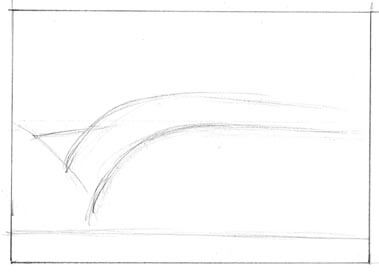
Footstep one
Sketch in the basic shape of the whorl, spray, foam and base of the wave.

Footstep ii
Add an actress line running parallel and below the curl line to define the thickness of the lip.
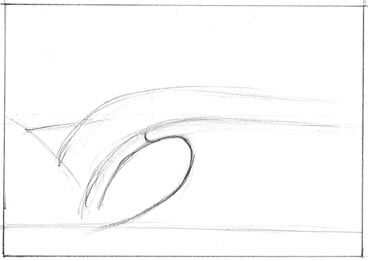
Pace 3
Add a flow line starting at the lip and curve it around to advise roundness of the liquid lip. Go on that same flow line around with a half oval downward to the base of the moving ridge to show the concave curve of the moving ridge face.
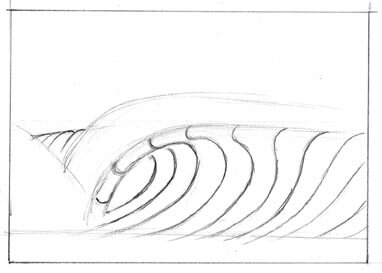
Step four
Add together the rest of the flow lines. Gradually make each flow line less steep every bit yous motility abroad from the curl, to show the tapered shoulder. Proceed the flow lines into the tube to show hollowness.
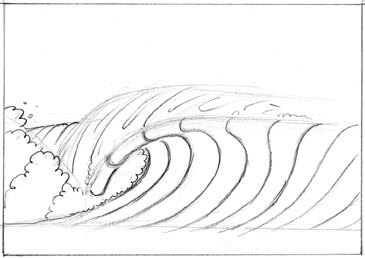
Pace 5
Add together simplified spray with sparse wispy lines. Add together the foam explosion with a series of explosion lines getting bigger equally they moving away. Maybe add a foam ball in the tube. Round off the foam at the base of the wave and so information technology won't expect flat.

Pace six
Add shading on the wave face up with smaller contour lines. Gradually make the lines darker every bit you get further into the tube. Use crosshatching to add more depth. Lightly shade foam and base of the wave. Maybe shade the sky a trivial, too.
Tips
- Don't go caught upwardly trying to draw every foam bubble, you'll go nuts.
- Using a sharp eraser, keep a defined white line under the lip so it looks separate from the wave confront.
- Add white highlights on the lip with your eraser to requite it sparkle.
The importance of perspective
Drawing a bones wave can be fun, but after a while it can get tiresome if y'all are merely following the same formula over and over again. The fundamental to breaking out of this potential rut is achieved by drawing waves from different angles. There is only one manner to successfully create a variety of angles and that is past using the bones principles of perspective. The 2 basic ingredients in perspective are the horizon line (your eye level) and the imaginary vanishing points. By merely changing the position of these ingredients in your epitome y'all'll be amazed at the variety of waves you can create. See the 2 sketches beneath:
A paddler's view
Low horizon. Vanishing point off left:

A pier view
High horizon. Vanishing point left:

A view into the tube
Additional variations can be achieved by moving the horizon line loftier or low and by moving the vanishing signal right or left. Give it a try:

A view out of the tube
A high horizon line and i vanishing signal on the left makes information technology look as if your face is against the face of the wave and y'all're racing for daylight (see outset two images below). And if you motion the vanishing point to the right and so more of the face up becomes visible (see last two images below):

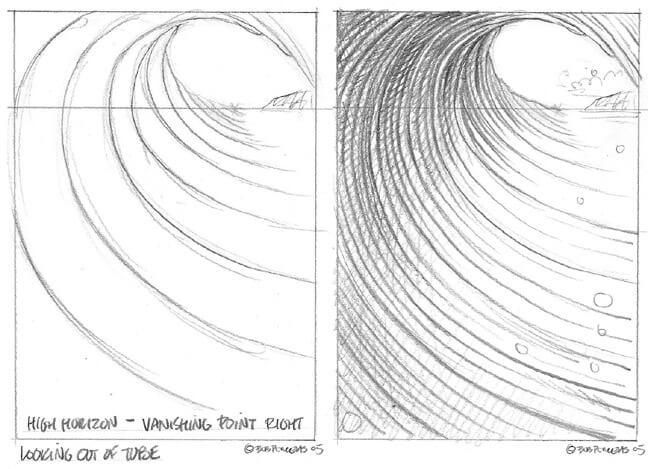
A view from a pier
A high horizon line with 2 vanishing points off to the right and left makes it appears every bit though you're viewing the moving ridge from a pier, looking down on the wave:

A paddler'southward eye view
A paddler'due south eye view can exist achieved by placing the horizon line extremely low. Both vanishing points are located outside of the image border, 1 to the left and one to the right:
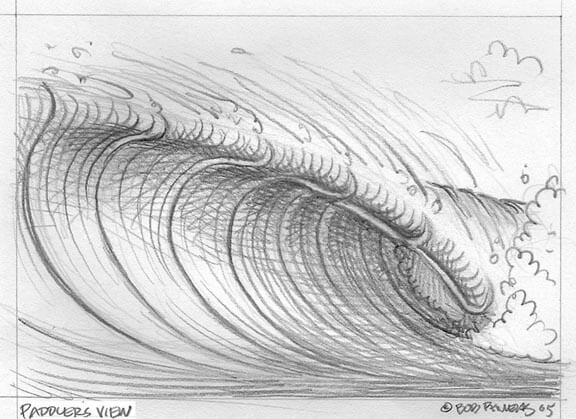
A bird'southward eye view
A bird'southward centre view can be accomplished by moving the horizon line upwards and completely off the prototype. The two vanishing points are positioned way out to the right and left:
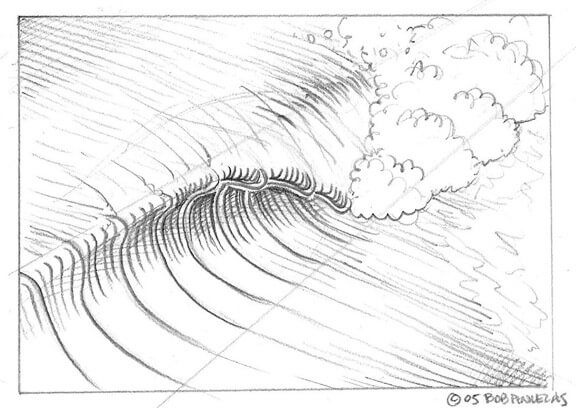
A down the point view
A view looking downward the point can likewise be achieved past moving these ingredients around:
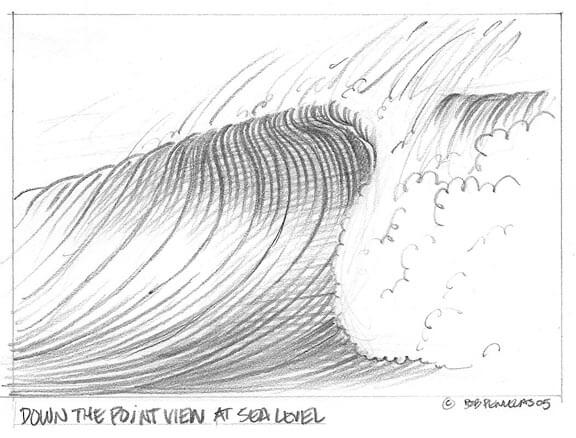
Various scenes
With perspective, you lot tin can now create line-up scenes, with multiple waves. It could be a reef pass, a embankment break or a betoken interruption Add land in the groundwork or in the foreground to requite the scene some depth. Encounter the four sketches below:

Unlike types of waves
Don't forget nearly hollow waves, freight-trains, slow-churning or paper-thin waves. The possibilities are endless:

Peaks
Avoid drawing a top by merely attaching ii mirror image waves together. The right and the left are the same yet they are drawn differently.
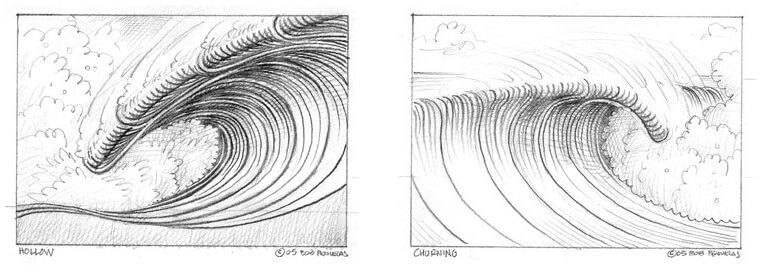

Add surfers
Don't forget to add surfers to your waves, whether y'all draw them regular or goofy pes, behind or frontside, you before long realize that in that location are endless combinations. See the iii sketches below:
A surfer doing a cutback on a moving ridge:

A surfer riding a big wave:

A side profile drawing of a surfer riding a barrelling moving ridge:

If yous enjoyed this tutorial, delight share it with your friends and followers. And share your drawings with us on Instagram or Twitter.
Curated by Bob Penuelas on Jun 24, 2008
Source: https://clubofthewaves.com/feature/how-to-draw-a-wave/
Posted by: knighthattlem.blogspot.com


0 Response to "How To Draw An Ocean Wave"
Post a Comment